Short on time? Our pick for the best tent for wind is the Kodiak Flex Bow VX.
Looking for the best tent for windy weather? I’ve got you covered with the best high-wind tents on the market.
Are your weekends chock-full of camping plans, but you’re worried about high winds?
Windy weather can be a massive drag on a camping trip; in the worst-case scenario, it can damage your gear and put you in danger.
I have camped on many a windy night, so I know the frustration of being tent-bound, nervously listening to the trees whip around outside.
I remember one night, my friend and I scared ourselves silly thinking someone (or some*thing*) was dragging a finger along the top of our tent.
Turns out it was my tent permit tag (facepalm).
I also recall the time in the desert when I foolishly left the fly unstaked, only to wake up in the middle of the night to a big, sandy windstorm.
While it’s no fun to camp in high winds, having a bomber tent for high winds makes all the difference to your comfort and safety.
Below I’ll help you find the best wind tent and whatever else the wind brings. Whether it be heavy rain, cold, or sand– this list has something to help you have the best time camping.
Note: this post contains affiliate links, which help run this site at no extra cost to you so I can keep providing free travel advice and tips.
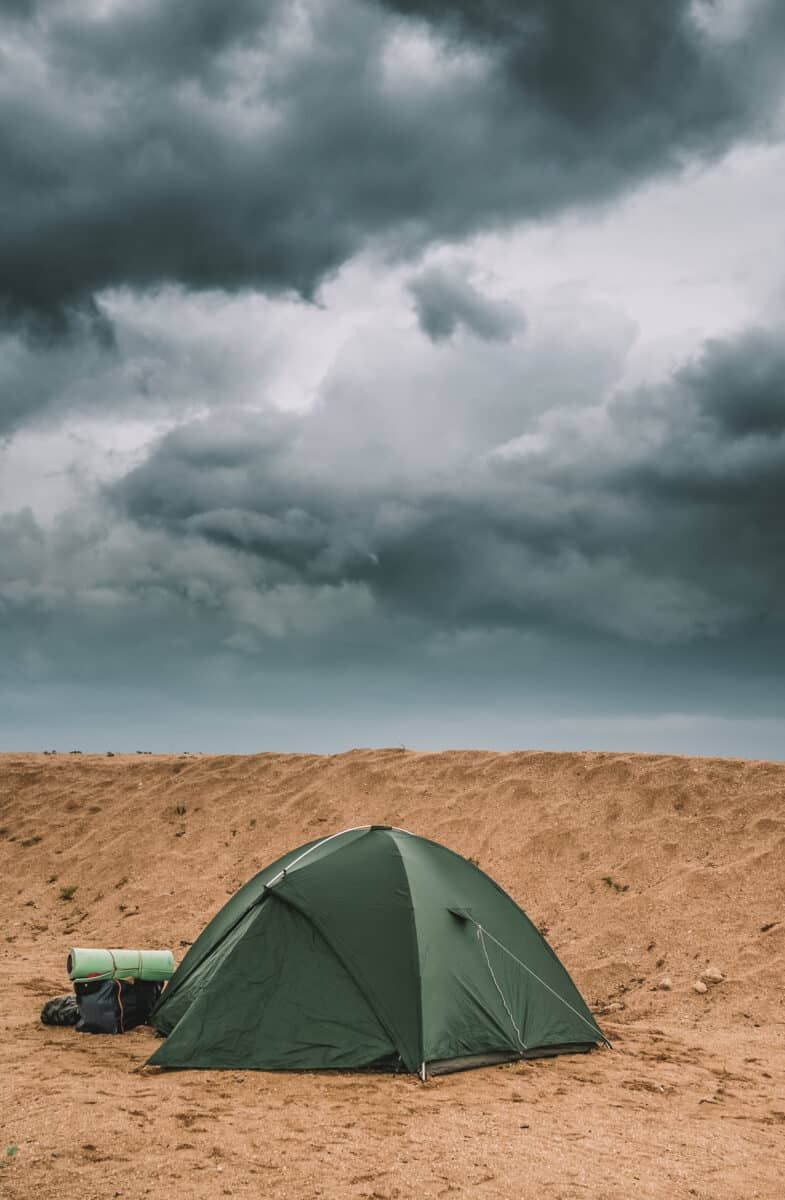
Here’s a quick look at our recommendations
- Best for Two-Person – MSR Access 2
- Best Four-Person Tent – Nemo Aurora Highrise 4P Tent
- Best Large Tent for Windy Conditions – REI Co-op Base Camp 6 Tent
- Best Family Tent for Wind – Whiteduck Alpha Canvas Wall Tent
- Best for Windy Beach Camping – North Face Assault 2 Futurlight
- Best Backpacking Tent – Big Agnes Copper Spur HV UL2
- Best Pop-Up Tent for Wind – Sierra Designs Convert
- Best Cabin-Style Tent – Kodiak Flex Bow VX
- Best for Rain and Wind – MSR Remote
- Best Tent for Wind and Cold – Whiteduck Regatta Canvas Bell Tent 16′
- Best for Extreme Wind – Black Diamond Eldorado
#1 MSR Access 2
Best Two-Person Tent For Wind
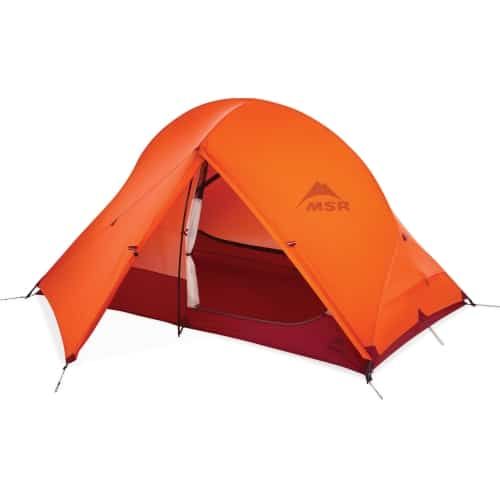
Our Rating: 4.9/5
Packaged Weight: 4lbs 1oz
Floor Area: 29 sq. ft
Center Height: 42″
Number of Doors: 2
Sleeps: 2
The most popular tent size is a two-person tent. Two-person tents will be spacious for one person but suitable for a friend joining your adventures.
The best tent for high wind that sleeps two people is the MSR Access 2, and there’s a lot to love about this weatherproof tent.
The Access 2 is a four-season, lightweight tent for ski touring and overnight shoe-snowing.
This high-wind tent uses extra strong Easton Syclone tent poles, which help the Access 2 withstand high snow and rain loads.
The tent fly has 20D ripstop nylon with a 1200mm poly/sil waterproof coating, and the floor uses 30D ripstop nylon with 3000mm waterproofing.
This excellent tent weighs just over four pounds. It has a double-wall construction with minimal mesh on the inner tent to keep you cozy in cold and windy weather.
The downsides to this high-wind tent are that the living space is small for two people and their gear. Additionally, the limited mesh is a perk in the winter but may cause the tent to feel stuffy in the summer.
PROS
- Four-season tent
- Extra-strong Easton Syclone Poles
- Xtreme Shield waterproof coating
- Editor’s Choice 2023 GearLab
CONS
- Limited living space for two people
- It may be hot in summer
#2 Nemo Aurora Highrise 4P Tent
Best Four-Person Tent for Wind
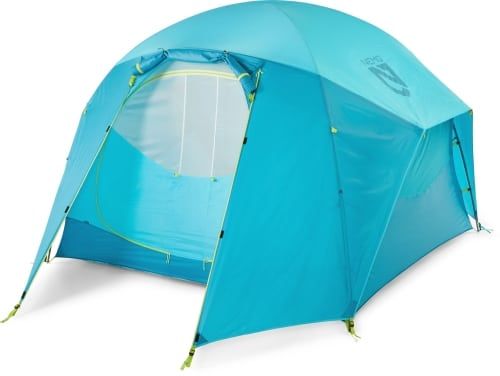
Our Rating: 4.8/5
Packaged Weight: 15 lbs 14oz
Floor Area: 62.5 sq. ft
Center Height: 75″
Number of Doors: 2
Sleeps: 4
Are you looking to camp with a small group? The best four-person tent for high winds is the NEMO Aurora Highrise 4P. The Aurora Highrise is a freestanding camping tent with two doors and two generous vestibules (19.5 square feet each).
The Highrise’s dome shape and aluminum tent poles make it a wind-resistant tent. The dome helps shed wind, while the sturdy aluminum poles are strong yet lightweight.
I love that the windows have little awnings over them that protect them from rain.
Another perk is that should anything happen to your tent, NEMO offers a lifetime warranty.
The Aurora Highrise has several gear lofts and storage pockets for organization, and the peak height is tall enough to stand in.
While I shy away from tall tents for windy camping, you will likely have so much gear and weight inside the tent with four people that there should be no danger of blowing away.
Two knocks on the Aurora Highrise are that the walls are steep. Usually, I consider this a good thing because it increases a tent’s livability, but vertical walls aren’t a plus for wind.
Finally, the fabric had no waterproof rating specs, so I can’t speak to the quality there, but unlisted specs often mean lower performance.
PROS
- Freestanding
- Large vestibule
- Dome shape
- Rain-protected side windows
- NEMO Lifetime Warranty
CONS
- No waterproof rating on the fabric
- Steep tent walls
CHECK PRICE ON:
#3 REI Co-op Base Camp 6 Tent
Best Large Tent for Windy Conditions
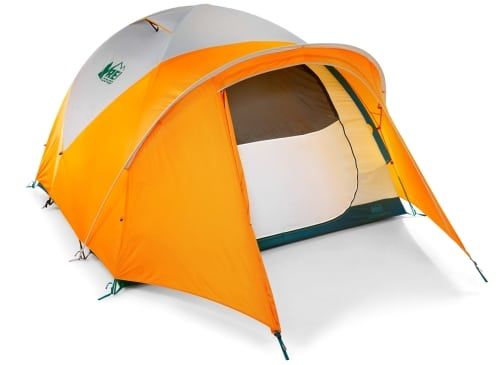
Our Rating: 4.7/5
Packaged Weight: 20 lbs 10oz.
Floor Area: 84 sq. ft
Center Height: 74″
Number of Doors: 2
Sleeps: 6
If you’re looking for a large tent with high wind resistance, The REI Co-op Base Camp 6 might suit you.
The Base Camp 6 sleeps six people, or, if you prefer to camp in comfort, it has enough floor space for two queen air mattresses.
Three significant features make the Base Camp an excellent tent for camping in the wind.
First, it’s a dome tent, so it sheds wind well.
Second, the color-coded poles make for an easy setup (no one wants a complex setup in high wind). And third: it has a full-coverage rainfly for maximum weather protection.
I like that this camping tent has aluminum poles, and I also love the wide-mouth doors. Not only is it easier to get an air mattress in and out, but you don’t have to crawl over anyone in the process.
The one downside about the Base Camp is that you should invest in sturdier stakes as the ones provided are a little wimpy for high wind conditions.
PROS
- Dome tent
- Color-coded poles
- Wide-mouth doors for easy access
- Full coverage rainfly
CONS
- Needs longer stakes
#4 Whiteduck Alpha Canvas Wall Tent
Best Family Tent for Windy Conditions
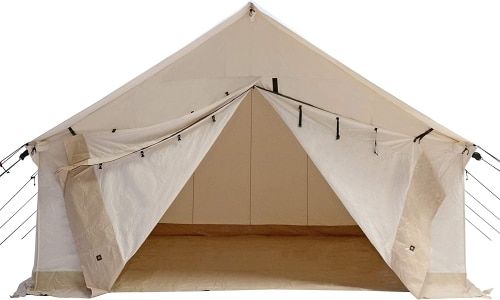
Our Rating: 4.8/5
Packaged Weight: 146 lbs
Floor Area: 80 sq. ft.
Center Height: 7’6″
Number of Doors: 1
Sleeps: 6
My grandpa left us his old canvas tent from the army that had bear claw marks on it, and for a long time, it was a family treasure.
I chose the Whiteduck Alpha Canvas Wall Tent as the best family tent for wind and rain because this huge high-wind tent can last for generations when you care for it properly.
Canvas is one of my top choices for wind resistance because it’s durable. Whiteduck uses a 10.10oz army cotton canvas with a water, mold, and UV-resistant finish.
The Alpha Canvas Wall Tent has a silicone-treated stove jack, so if you want to set up a backcountry stove, you can do so safely. Backcountry stoves, by the way, are the *stuff.*
Another weatherproof feature I love on this tent is the triple-layer mesh and fabric on the doors and windows.
The downsides to this family camping tent are similar to those of all canvas tents. The Alpha is no budget tent, and it’s also a heavy tent weighing 146 pounds. But on the plus side, it *definitely* won’t blow away!
PROS
- Heavy-duty canvas
- Built-in stove jack
- Removable floor
- “Storm door” with triple layer fabric on windows
CONS
- Heavy
- Expensive
CHECK PRICE ON:
#5 North Face Assault 2 Futurlight
Best Tent for Windy Beach Camping
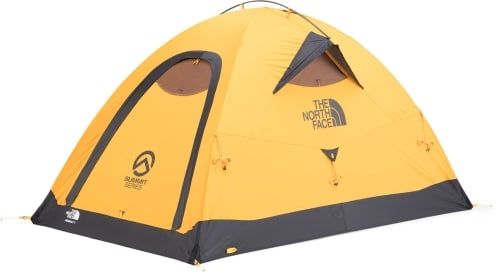
Our Rating: 4.7/5
Packaged Weight: 5 lbs 15 oz.
Floor Area: 26.8
Center Height: 41″
Number of Doors: 2
Sleeps: 2
Are you looking for the perfect beach tent for windy days?
Beach camping presents a unique challenge when you’re tent camping because it’s hard to stake a tent down in squashy sand.
There are several reasons why The North Face Assault 2 Futurlight Tent makes a fantastic beach tent for wind.
The North Face designed the Assault 2 for mountaineering, but many design features lend themselves to beach camping.
First, this is a single-wall tent with minimal mesh, meaning minimal sand will fly through the walls. However, there is ventilation on the doors and sides, meaning it won’t become too sweaty.
The freestanding, single-wall design is perfect for the beach because it eliminates the need for stakes, which don’t work well in sand.
Additionally, the tent poles on this little beauty are top-of-the-line carbon fiber, meaning they will easily stand up to strong winds.
Finally, this lightweight tent is perfect for a backpacking trip. One knock on the Assault 2 is that the interior space is a wee bit small.
PROS
- The minimal mesh keeps sand out
- Lightweight
- Single-wall design
- Freestanding
- Solid carbon fiber tent poles
CONS
- Small floor area
#6 Big Agnes Copper Spur HV UL2
Best Backpacking Tent for Wind
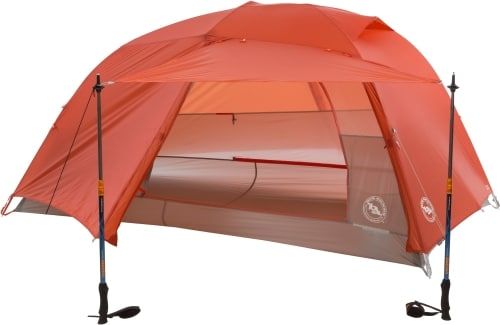
Our Rating: 4.9/5
Packaged Weight: 3 lbs 2 oz.
Floor Area: 29 sq. ft
Center Height: 40″
Number of Doors: 2
Sleeps: 2
If you’ve got the backcountry in your heart, you need a good backpacking tent for wind.
I have often written about the Big Agnes Copper Spur HV UL2 Tent because it’s such a popular camping tent and a perfect backpacking tent for high winds.
Let’s get into it. The Copper Spur is a freestanding tent (a must-have for high winds), although the awnings require trekking poles, and I doubt they will stay standing in a storm.
This ultralight tent for wind is just over three pounds, but it features double ripstop nylon, which is extra tear-resistant–- a feature you won’t find on many other tents.
The seams have waterproof polyurethane tape free of VOCs and PVCs, chemicals that can irritate some campers.
To add to the weatherproofing, little storm flaps over the vestibules keep the rain out.
My favorite feature of the Big Agnes Copper Spur is the abundance of gear lofts and storage pockets.
The media storage pockets feature little earbud cord holes, so you and your partner can catch up on Vampire Diaries while you wait out the storm.
PROS
- Ultralight tent
- Freestanding
- Low profile
- Double ripstop nylon is extra tear resistant
- Storage pockets and more than one gear loft
CONS
- Awning requires trekking poles
#7 Sierra Designs Convert
Best Pop-Up Tent for Wind
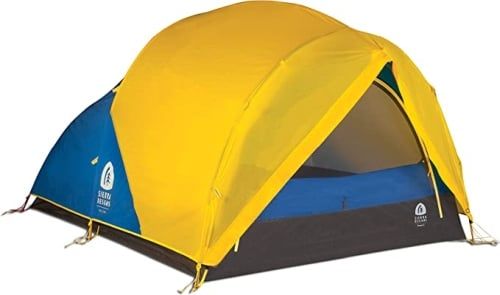
Our Rating: 4.6/5
Packaged Weight: 5.8lbs
Floor Area: 30.3 sq. ft.
Center Height: 43″
Number of Doors: 1
Sleeps: 2
The Sierra Designs Convert is my pick for the best pop-up tent for high winds.
This lightweight backpacking tunnel tent stands up to all four seasons. My favorite windy-savvy feature about the Convert is that the inner tent is fully sealable, even without the fly attached.
In fact, the reason they named it the “Convert” is because you can camp fully protected without the fly, or you can use the fly to give your space more living room with an enormous vestibule.
This feature also makes it the best tent for desert wind because you don’t have to haul around the extra fly (which will also make the tent warmer), but you can still keep all the flying desert grit out.
This high-wind tent offers excellent wind resistance with its tunnel shape and low-profile peak height.
Note that the peak height is still enough for even most tall people to sit upright inside.
Although this is a fantastic pop-up tent, some users had difficulty setting it up the first time (a common problem with any tent, TBH), and getting it re-packed in the original stuff sack is difficult.
PROS
- Aluminum poles
- Four season tent
- Lightweight
- Tunnel tent sheds wind well
- Fully sealable tent, even without the fly
CONS
- Challenging setup the first time
- Hard to re-pack into a stuff sack
#8 Kodiak Flex Bow VX
Best Cabin-Style Tent for Wind
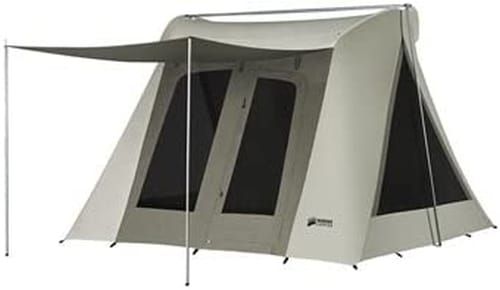
Our Rating: 4.9/5
Packaged Weight: 30.5 lbs
Floor Area: 51 sq. ft
Center Height: 48″
Number of Doors: 2
Sleeps: 2
After you read my buying guide, you’ll notice that I usually wouldn’t recommend a cabin-style tent for high winds.
Still, canvas tents are an exception, and the Kodiak Flex Bow VX is a notable anomaly because of how well-made it is.
Have no fear about this cabin-style tent blowing away. The Kodiak Flex Bow VX has a thick cotton duck canvas, and it weighs over 30 pounds. This baby ain’t goin’ nowhere.
Since it’s so heavy, it’s unsuitable for backpacking–this is, without a doubt, a car camping tent.
The Flex Bow VX is Kodiak’s smallest canvas model; it sleeps two but has a highly generous floor area of 51 square feet–a floor plan you won’t see on other tents.
The peak height on the Flex Bow VX is 48″, which is a tall height when it comes to synthetic tents. However, canvas camping tents are usually much larger, and four feet is still low profile enough that it won’t catch the wind.
PROS
- Made with high-quality canvas cloth treated with Hydra-Shield
- Tons of living space
- 12″ steel stakes
- Easy setup
- Low profile peak height
CONS
- Heavy
#9 MSR Remote
Best Tent for Rain and Wind

Our Rating: 4.8/5
Packaged Weight: 7lbs 2 oz
Floor Area: 33 sq. ft
Center Height: 44″
Number of Doors: 2
Sleeps: 2
Are you prepping for wind and rain? If you’re preparing for one, you should prepare for both since they tend to travel together.
The MSR Remote expedition tent will have you covered— literally! The MSR Remote is a mountaineering tent, so it’s a high-quality piece of equipment specifically designed for max wind resistance, snow loads, and heavy rain.
The Remote is a dome tent with a central-support frame that can handle high snow loads and severe rainfall.
The fabrics on the Remote have a proprietary DuraShield (3000mm on the fly and 1500mm on the tent body) and a bathtub-style floor to keep you dry.
Finally, MSR redesigned the Remote with a fly that better disperses condensation, another crucial component when you’re stuck in a tent for extended periods.
As for the downsides to the Remote, any high-quality tent for high winds won’t exactly be a budget tent. Additionally, (and disappointingly for such an expensive tent) the carbon fiber poles aren’t sealed, so it’s possible to get little carbon fiber shards in your hand.
PROS
- Expedition tent
- Bathtub style floor
- Dome tent
- Newly designed fly reduces condensation
CONS
- Expensive
- Carbon fiber poles are not sealed.
#10 Whiteduck Regatta Canvas Bell Tent 16′
Best Tent for Cold and Wind

Our Rating: 4.6/5
Packaged Weight: 83-90 lbs
Floor Area: 804.25 sq. ft
Center Height: 9’8″
Number of Doors: 1
Sleeps: 8
The best tent for high wind and cold will undoubtedly be a canvas tent with a stove jack and plenty of room for glamping accessories. Behold, the Whiteduck Regatta Canvas Bell Tent 16′.
This colossal canvas bell tent features an 8.5 oz army cotton canvas treated with water, mold, and UV-protecting finish. The Regatta is the best 8-person tent for wind, or you can stuff it full of comfy mattresses and make it a cozy luxury tent for a smaller number of people.
There is a lot to love about Whiteduck products. Their canvas bell tents have double-stitched seams for added strength, and the poles have ultra-strong galvanized steel.
The Regatta has a sewn-in polyethylene groundsheet and a built-in stove jack to keep heat in and critters out.
Camping in a canvas tent with a wood-burning stove might sound sketchy, but it’s awesome, cozy, and safe so long as you don’t sleep too close to it.
Note that Whiteduck makes smaller bell tents. If you opt for the 16′ version, you’ll need help setting it up, as it weighs nearly 100 pounds.
Interested in tents with stove jacks? Check out our picks for the best ones!
PROS
- Galvanized steel poles
- Built-in stove jack
- Reinforced seams
- Heavy-duty canvas with mold, water, and UV-repellent finish.
CONS
- Very heavy
- Multiple-person setup required
CHECK PRICE ON:
#11 Black Diamond Eldorado
Best Tent for Extreme Wind
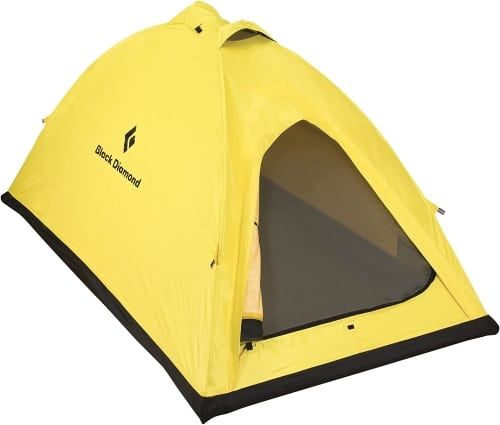
Our Rating: 4.7/5
Packaged Weight: 5 lbs 1 oz
Floor Area: 30.8 sq. ft
Center Height: 43″
Number of Doors: 1
Sleeps: 2
Last, the best tent for high winds–or extreme windiness–is the Black Diamond Eldorado.
The Eldorado is a single-wall mountaineering tent. Despite what others might say about the utility of a single-wall tent for windy conditions, the Eldorado performs like a champ in extreme mountaineering environments.
The newly designed two-person tent is essentially the same tent as its predecessor, but it’s a scootch bigger and only has two poles for easy setup. The Eldorado is fully sealable against the elements, ensuring any rain accompanying high wind will remain out.
Black Diamond uses their proprietary ToddTex fabric on the Eldorado. I couldn’t find the typical gear specs on ToddTex, but the reviews are excellent. It holds up well against wind and is more resistant to UV degradation than lesser single-wall fabrics.
While the Eldorado gets excellent reviews, remember that this is a single-wall tent, so dispersing condensation will invariably be an issue. Finally, at 30 square feet, it’s on the small side for two people with gear.
PROS
- Suitable for extreme winds
- New design is 5’’ longer and 3’’ wider
- Easy setup
- Durable ToddTex fabric
CONS
- Single-wall design
- Small for two people
Buying Guide: How to Choose the Best Tent for High Winds
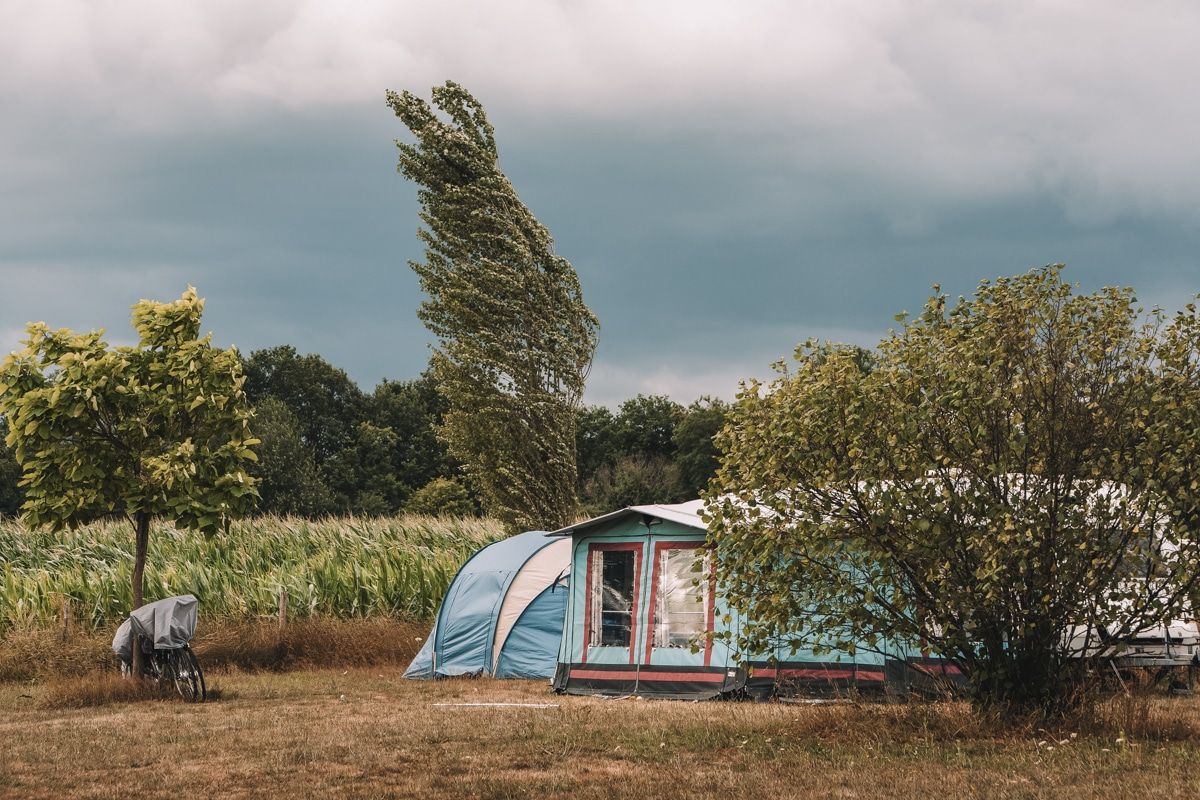
What to Look for in Windproof Tents
While storm intensity and campsite location factor into how your tent performs, here are some general guidelines for high-wind tents.
Size
The best-sized tent for windy weather will be a small, low-profile tent. Larger tents (especially synthetic ones) with high profiles can catch the wind and turn into giant sails.
There are some exceptions: the thick and heavy canvas will help a large canvas tent withstand high winds.
Living Space
If windy conditions scuttle your camping trip, you’ll likely spend a lot of time inside the tent. Ensure you have ample interior space for all your companions or perhaps a gear loft, as you won’t want to keep your equipment outside in high wind and rain.
Shape
The best wind-resistant tents are typically dome-style tents, tunnel tents, or any round shape. For wind resistance, you should shy away from cabin tents with their vertical wall design.
A rounded shape is more aerodynamic, allowing wind to flow over the top rather than smack into the side of the tent.
Domed tents are the most popular tent shape, so it’s thankfully not hard to find this style.
Tunnel tents are shaped like a pipe cut in half and laid on the flat side, and they also resist high winds with their curved walls.
Freestanding
I highly recommend a freestanding tent for windy weather conditions. Freestanding tents are the best high-wind tents because they don’t need tent stakes or guy lines to stay upright (although they almost always need stakes and guy lines to keep the rain fly in place).
Nonfreestanding tents don’t perform well in strong winds because if the tent stakes become loose (i.e., from the muddy ground or high winds), the tent can collapse.
Single or Double-Wall
There is debate about whether a single or double-wall tent performs best in windy weather.
A single-wall tent uses one sheet of fabric for the entire tent.
On the plus side, you won’t have to deal with a loud, flapping rain fly in high wind. On the downside, a single layer of fabric may not be as wind resistant as a double layer (except canvas, which is a single layer and super strong).
Double wall tents have an inner tent made partially of mesh. Many people prefer double walls for high-wind tents because the rain fly plus the inner tent provide extra protection.
I have only ever used double-wall tents, and I will just say that if you don’t get the rain fly cinched down *toight*, you will deal with a loud, flappy nylon torture device all night.
So pick your poison. Or watch this Youtube video to learn more about the differences between the two.
Material
Everyone wants a durable tent, regardless of the type of weather they plan to recreate in. Regarding a wind-resistant tent, I would shy away from ultralight materials as they tend to be thinner.
Canvas is an exceptionally wind-resistant material and does well in wet weather. The main downside of using a canvas tent is that they are large and heavy.
If you’re shopping for a synthetic wind-resistant tent, look for materials with a high Denier (D) rating. The higher the Denier, the thicker the material.
Full Coverage Rain Fly
If you choose a double wall tent and know you’ll be camping in high winds, ensure you have full coverage rain fly.
Some ultralight tent models have a cutaway fly that only covers the top of the tent but leaves the sides of the inner tent exposed.
You want your fly to cover your entire tent so the windy conditions don’t rip the fly off.
Bathtub Style Floor
Windy and rainy conditions often come together, so look for a bathtub-style floor for maximum weather protection.
A bathtub-style floor extends the thickest, most waterproof part of the tent floor up a few inches along the sides of the tent (like a bathtub) to protect you from flowing water that might pool against the outside tent.
Sealed Seams
The ideal tent for high-wind camping will also have sealed or taped seams. Often a waterproof tent will come with factory-sealed seams, but you can also purchase waterproof seam sealant separately for an extra dose of weather protection.
Seasons
Opt for a four-season tent if you plan to camp in inclement weather. Four-season tents can withstand high winds and winter camping conditions.
Poles
Your choice of tent poles can make a massive difference to your comfort in windy weather.
Steel is the gold standard for high-wind tents because it’s the strongest material, but it’s also cumbersome and uncommonly used with synthetic tents. You’re more likely to get steel poles if you have a canvas tent.
Aluminum poles would be the next best option for high-wind tents. Aluminum tent poles are lighter and stronger than fiberglass poles and, thankfully, a common pole material for most tents from reputable tentmakers.
Carbon fiber poles are rare. Carbon fiber poles are slightly lighter and stronger than aluminum poles but are often quite expensive.
Fiberglass poles are a common choice for a budget tent. Fiberglass, not to be confused with carbon fiber, is the cheapest tent pole material. Whether fiberglass can withstand strong winds depends on the pole design.
Easy Setup
Last but not least, if you find yourself in a high-wind camping situation, you’ll want a tent that sets up easily and quickly, especially if you like to camp alone. Strong winds will blow your tent fabric all over, so consider ease of setup before you buy.
Types of Tents for Windy Conditions
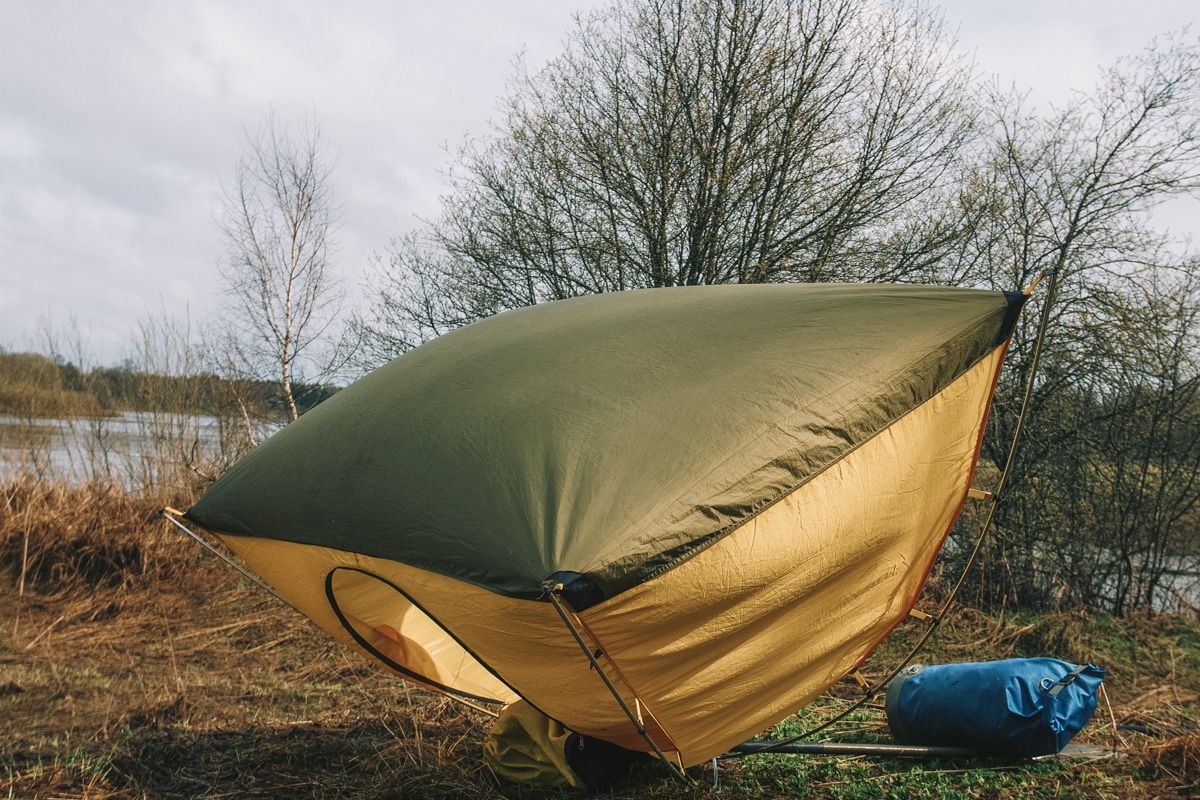
Synthetic Dome Tents
Dome-style tents are best for heavy wind because the curved sides allow the current to flow over the tent. If you purchase a dome tent, remember that some dome tents can be very tall and that the most wind-resistant tent will be small with a low profile.
Synthetic dome-style tents are best for family camping or a backpacking trip.
Canvas Tents
Some of the best tents for high winds are canvas. This material has very high wind resistance because of how thick and durable it is.
Tents made from canvas are heavy, large, and expensive and require dedicated care to ensure they don’t get mildewy (that is true of all tents, however).
Canvas is the best tent material for campers needing a semi-permanent shelter (i.e., hunters or glampers) who plan to camp in the front country.
Synthetic Tunnel Tents
A tunnel tent has similar windproof qualities as a dome tent. It gets its wind resistance from its curved sides. Tunnel tents tend to come in larger sizes than dome-style tents, so tunnel tents are an excellent choice for camping with a group.
Expedition Tents
Expedition tents are built especially for extreme weather in freezing and windy environments (like high mountain tops or the poles). These are fantastic tents for high winds because their durable materials can withstand extremes.
FAQs About Windproof Tents
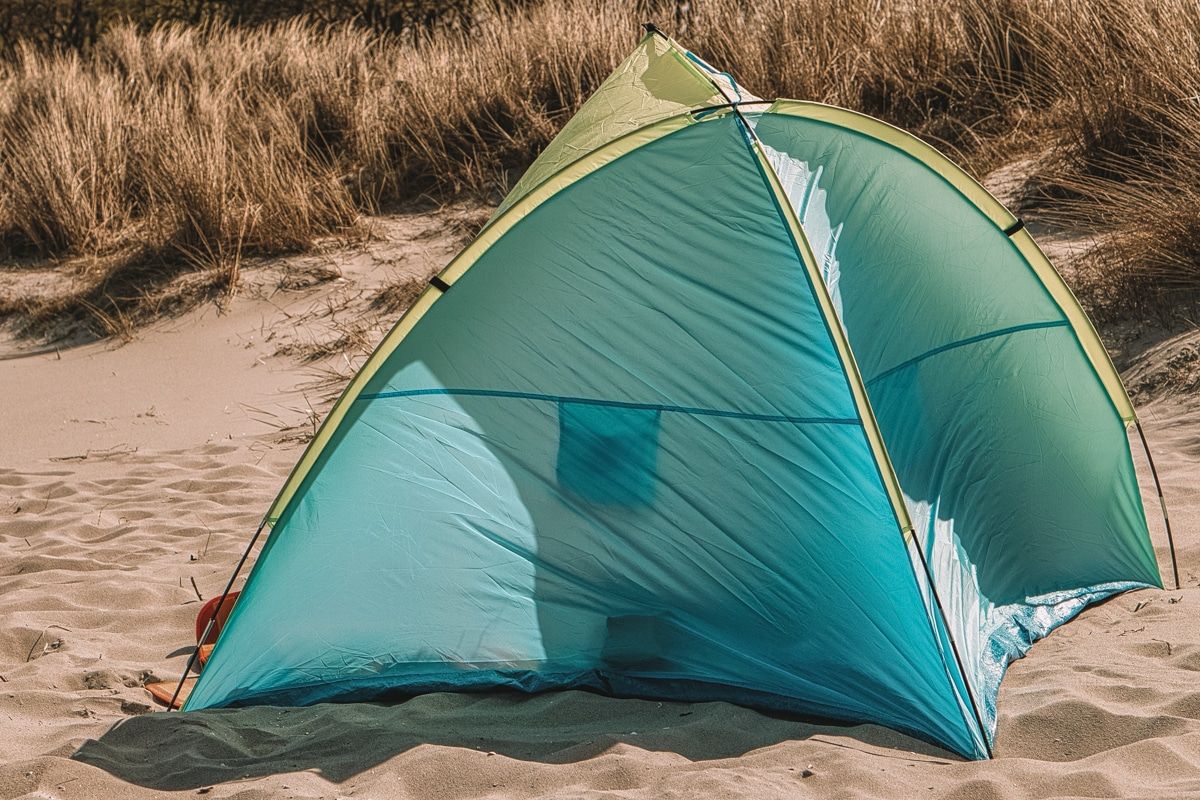
What is the best type of tent for wind? Are dome tents better in the wind?
When looking for the best tent for high wind, you have several good options.
Camping tents made of canvas, synthetic tents shaped like domes or tunnels, or synthetic double-wall tents provide better wind protection than other tents.
Large or tall tents don’t perform as well in windy conditions, so you’re unlikely to find a good 10-person tent for wind, for example.
Are canvas tents good in wind?
Some of the best tents for high wind are canvas. It’s an extremely thick, durable, waterproof, yet breathable material that does well in many weather conditions where synthetic tents fail.
Canvas not only has a high material strength but is quite heavy, preventing it from being blown around in the wind. Unlike thinner, noisier synthetic materials, a canvas tent will provide the quietest and warmest camping experience.
How high of winds can a tent withstand?
Generally speaking, tents can withstand 20mph winds without being staked down and up to 40mph with the stakes in.
Once the wind picks up around 50mph, even a windproof tent will have some issues.
How much wind a tent can withstand depends on several factors. Don’t forget– sheltering your tent from high winds behind a large boulder or other sturdy natural features will improve its wind resistance.
How do you block wind in a tent?
Even if you already have the best tent for high wind, there are extra steps you can take to maximize your protection.
- Pick a campsite that’s naturally sheltered from the wind, avoiding dead trees or damaged limbs. Camping among a stand of trees will shelter you from the wind, but be very careful not to camp within the fall line of a dead tree or beneath branches that appear weak, damaged, or dead.
- Use your car as a wind block.
- Create a wind block by tying up a tarp at a 45-degree angle in front of your tent. Ensure the tarp is well secured, so it does not break loose and become a hazard.
What tent pegs are good for wind?
You may already have a tent for strong winds, but are your tent pegs up to snuff?
High winds can rip and bend thin tent stakes out of the ground. I like these Neso Ground Screw Stakes because the corkscrew design keeps them firmly in the ground better than straight stakes.
How do you set up a tent in high winds?
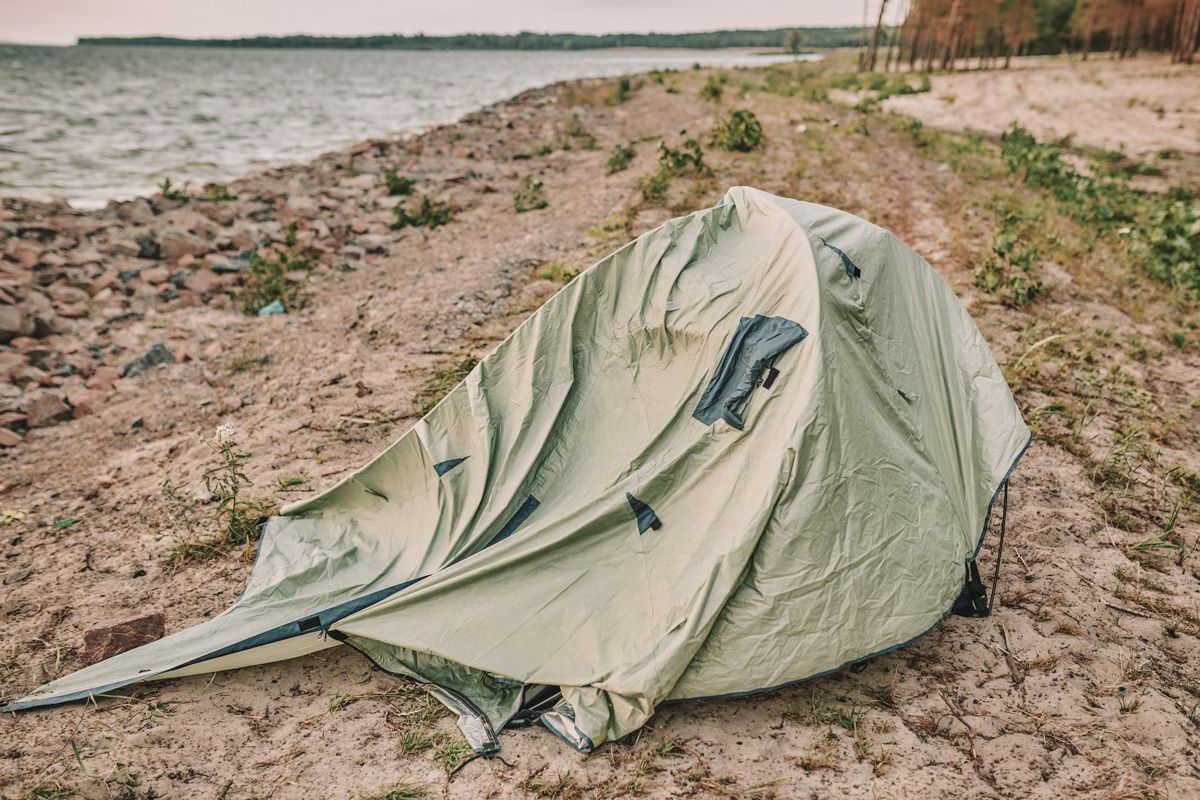
- Set your tent up correctly, with all the guy lines fastened securely and tightly.
- If the wind steadily comes from one direction, set the smallest side of your tent facing the wind.
- Replace thin tent stakes with stronger ones like these Neso Ground Screw Stakes.
- Put your tent stakes into the ground at a 45-degree angle away from the tent rather than vertically into the ground.
- Use a separate stake for each guy line rather than hooking multiple guy lines to one tent peg. That way, if the peg comes loose, only one guy line will become loose.
- If your tent has a large awning or porch area, consider taking it down and securing it, providing one less surface for the wind to catch and send your tent flying.
- Check your guy lines every morning and evening to ensure they have remained taut.
How do you secure a tent in high winds?
If the wind has already kicked up and your tent isn’t locked down yet, I recommend first putting on your sunglasses or other eye protection (if you have it) to protect your eyes from dirt or whipping cords and guy lines.
Place your tent in the most sheltered location you have. Consider using your car as a windbreak if you’re in the front country. Or, look for boulders, brush, or sturdy tree lines if you’re not.
Point the smallest side of your tent into the wind. Point the door away from the wind if you’re in a dome tent. Stake out the tent using every guy line, hammering the stakes into the ground at a 45-degree angle away from the tent.
Is it okay to be in a tent during a storm? Is it safe to camp in high winds?
There is no cut-and-dried, failproof answer on how to keep yourself safe during a storm.
The severity of the storm, your campsite location, the quality of your gear, and your proximity to aid factor into whether it’s ok to be in a tent during a storm.
Here are some essentials you should know if you’re camping in a storm:
- If a campground host or park ranger advises you not to camp, listen to them. They know what they’re talking about.
- A tent will not protect you from lightning. Your car offers better lightning protection, so don’t camp in lightning unless you don’t have another choice.
- Most simple three-season tents will start to break down between 40-50mph. Most people’s wills to camp break down well before that– don’t be a hero.
- Don’t camp within the fall line of a tree in high winds. Dead and damaged trees are hazardous, but even live trees can and have killed campers.
- Use your gut. If you feel unsafe, or you’re simply not having fun, it’s time to bail.
Conclusion: Our Pick for the Best Tent for Wind

No (sane) person likes camping in high wind, but if you spend enough nights outdoors, you’ll invariably find yourself in a storm of some kind. Be prepared for that crummy day with a tent that can withstand wind.
Although there are many excellent camping tents on my list, my final pick for the best tent for windy conditions is the Kodiak Flex Bow VX.
Yes, this is a cabin tent, but the specs on the Flex Bow are so impressive that there’s virtually no fear that this tent will blow away. Plus, you get all the livability of cabin tents.
This two-person tent has 51 square feet of living space and a peak height of four feet–tall enough to be livable yet low-profile sufficient to avoid major gusts.
I love that the Flex Bow comes with heavy-duty steel stakes, and the canvas material is sturdy and breathable.
Finally, forget the cheapy fiberglass poles. The Flex Bow comes with ⅜” steel poles which are strong enough for even big storms.
ABOUT THE AUTHOR

Meredith Dennis
Meredith is a biologist and writer based in California’s Sierra Nevada. She has lived in 6 states as a biologist, so her intel on hiking and camping is chef’s kiss next level. One of her earliest camping memories was being too scared to find a bathroom at night on a family camping trip. Thankfully, she’s come a long way since then and she can help you get there too!
Shopping for camping gear? Check out these related articles below!
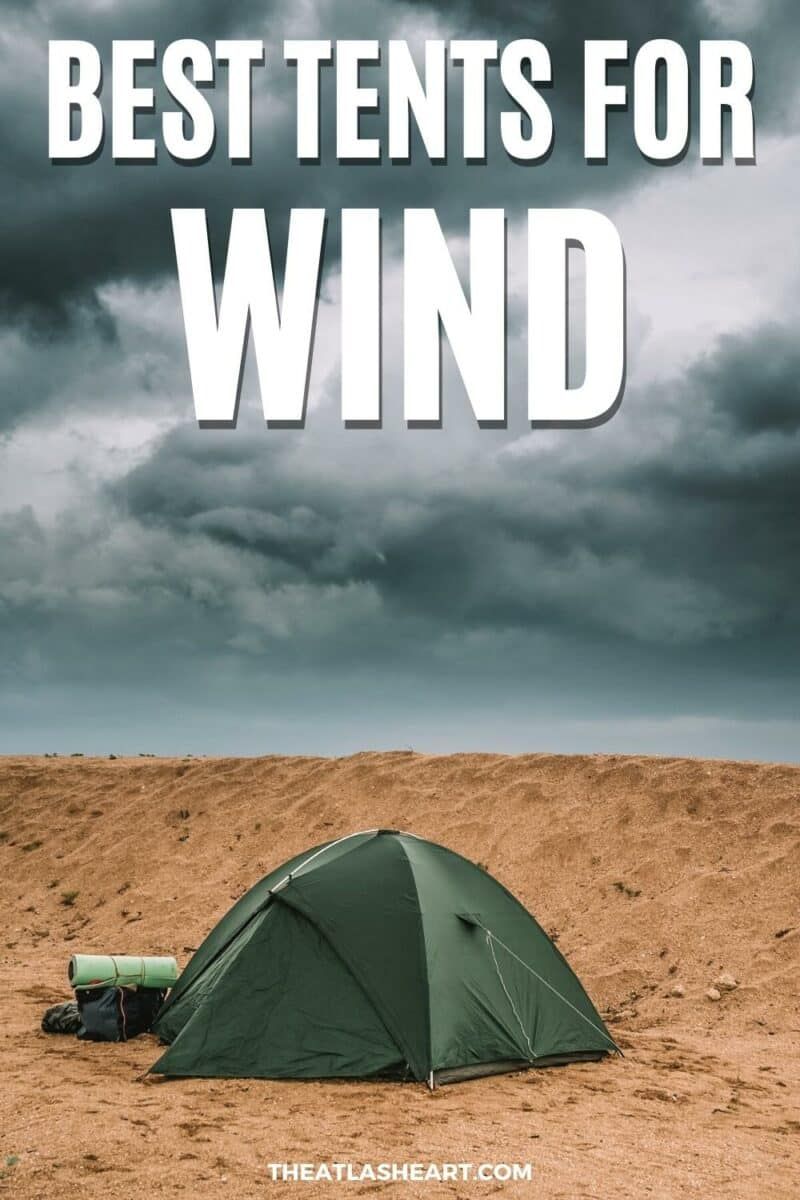
Pin this image for future reference


